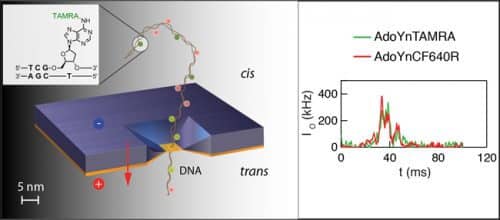Israeli-German development enables accurate identification of processes related to cancer development

A group of researchers from the Faculty of Biomedical Engineering has developed an innovative method for detecting disruptions in DNA molecules, by transferring them through nano-nozzles. The study, recently published in the journal ACS Nano, focuses on the discovery of hypomethylation in the DNA molecule - a process that in many cases indicates the development of cancerous tumors. The research was led by doctoral students Tal Gilboa and Chen Torpstein from the laboratory of Prof. Amit Meler in the Faculty of Biomedical Engineering at the Technion.
Methylation is one of the essential processes in the life of the organism, as it plays a central role in the genetic expression process that translates the instructions encoded in DNA to create proteins. Disruptions in the methylation process can lead to various diseases, including cancer. These disruptions result from one of two processes in the promoter region, where the genetic translation process begins: (1) increasing the genetic expression of cancer-causing genes following a decrease in their methylation level, or (2) the silencing of cancer-inhibiting genes, such as p53, following an increase in the methylation level. The methods that currently exist for monitoring the methylation levels in DNA molecules are based on averaging (meaning average) the information obtained from a large number of molecules. This is a very significant limitation because cancer tumors are characterized by high heterogeneity, that is, by a considerable difference between the methylation levels of the different cells within the tumor (intratumoral heterogeneity).
The new technology is based on the transfer of the DNA molecule inside a nanopore bio-sensor, and the methylation levels in the molecular components are measured in two ways at the same time - optically and electrically. According to Prof. Meller, "it is a simple and fast method compared to the alternatives. The crossover between the data obtained at the same time - the optical and the electrical - provides us with information at the single molecule level, that is, relevant and effective information for the diagnosis of cancer cells. In the article in ACS Nano, we actually present a proof of feasibility for an innovative and original technology that has great potential to develop into clinical use that will help diagnose cancer at a very early stage, and this is based on testing single DNA molecules."
The research was conducted by the research team of Prof. Amit Meller from the Faculty of Biomedical Engineering, the Interdisciplinary Program for Nanosciences and the Lockey Center for Life Sciences and Engineering at the Technion, in collaboration with researchers from Germany and Tel Aviv University. The collaboration between the Technion and Aachen University is based on the start-up grant under the umbrella cooperation program, which was given to Prof. Meller and Prof. Elmer Weinhold by the Technion's Deputy President's Office for Research. Additional funding was received from the European Union within the BeyondSeq consortium.

One response
Somehow for 2 decades it seems that every moment there will be a breakthrough, that cancer will be attacked from a general direction, and that some common types of cancer will become an easily curable disease with few side effects.
In practice this does not seem to happen. This is of course a complicated disease, but probably much more than they thought